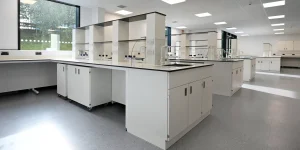Chemistry laboratories are hubs of scientific exploration and discovery, where precision and safety are of utmost importance. The design and arrangement of lab furniture, particularly working tables and shelves, play a crucial role in facilitating effective and safe laboratory operations.
Essential Features of Lab Furniture
Durability and Resistance
Lab furniture, such as tables and shelves, must withstand the harsh conditions often present in chemical laboratories. They should resist corrosion, heat, and chemical spills. Materials like stainless steel and chemically-resistant laminates are commonly used for their durability and ease of cleaning.
Safety and Ergonomics
Safety is paramount in a lab setting. Furniture must have features like rounded corners to prevent injuries and ergonomic designs to ensure comfort during long hours of work. Proper height and depth of tables and shelves are crucial to prevent strain and facilitate easy access to lab equipment.
Storage and Organization
Shelves and cabinets in chemistry labs provide essential storage space. They organize chemicals and equipment, reducing clutter and the risk of accidents. Transparent doors and labeling systems aid in quick identification of contents, enhancing efficiency.
Customization and Flexibility
Every lab has unique needs based on the type of research conducted. Customizable lab furniture that can adapt to different requirements, like adjustable shelves and modular table designs, is highly beneficial.
Impact on Lab Efficiency and Cost
Enhancing Productivity
Well-designed lab furniture like chemistry lab furniture streamlines workflow. It reduces the time needed to locate and access various chemicals and tools, directly impacting the lab's overall efficiency.
Cost-Effectiveness
Investing in high-quality lab furniture may have a higher initial cost, but it's cost-effective in the long run. Durable materials and thoughtful designs reduce the need for frequent replacements and repairs, offering long-term savings.
Energy Efficiency and Environmental Impact
Modern lab furniture often incorporates energy-efficient designs, like fume hoods that minimize air conditioning needs. This not only reduces operational costs but also lessens the environmental footprint of the laboratory.

Specifications and Dimensions: Tailoring to Lab Needs
Customizable Dimensions
Lab tables and shelves come in various sizes. Standard table heights range from 30 to 36 inches, with widths varying based on the lab's spatial requirements. Shelving units are typically between 12 to 18 inches deep.
Material Specifications
Common materials for lab furniture include stainless steel, phenolic resin, and epoxy resin. Each material has specific qualities like heat resistance, load-bearing capacity, and resistance to chemicals, making them suitable for different lab environments.
Conclusion
The design and quality of working tables and shelves in chemistry laboratories are critical to the overall functionality and safety of the lab environment. Investing in well-designed, durable, and efficient lab furniture is not just a matter of convenience but a necessity for the smooth operation and long-term sustainability of any chemistry laboratory.
